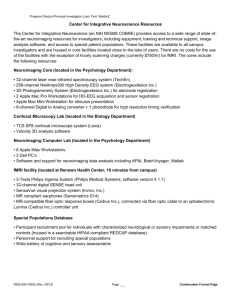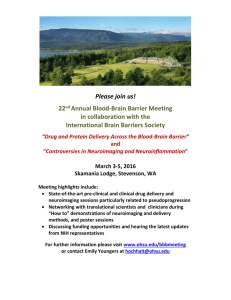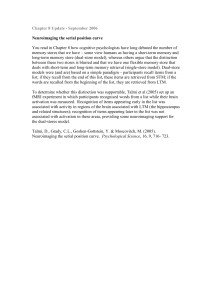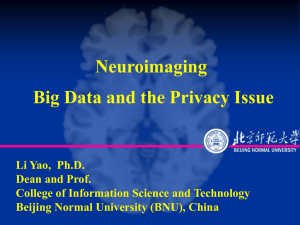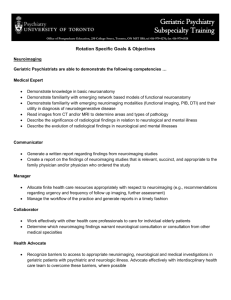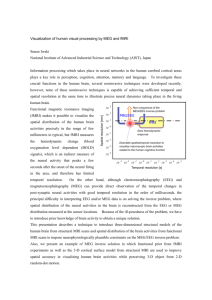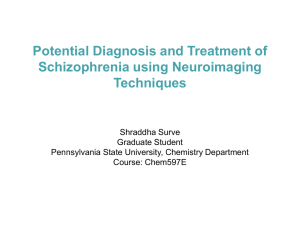This syllabus meets the standards required by
advertisement
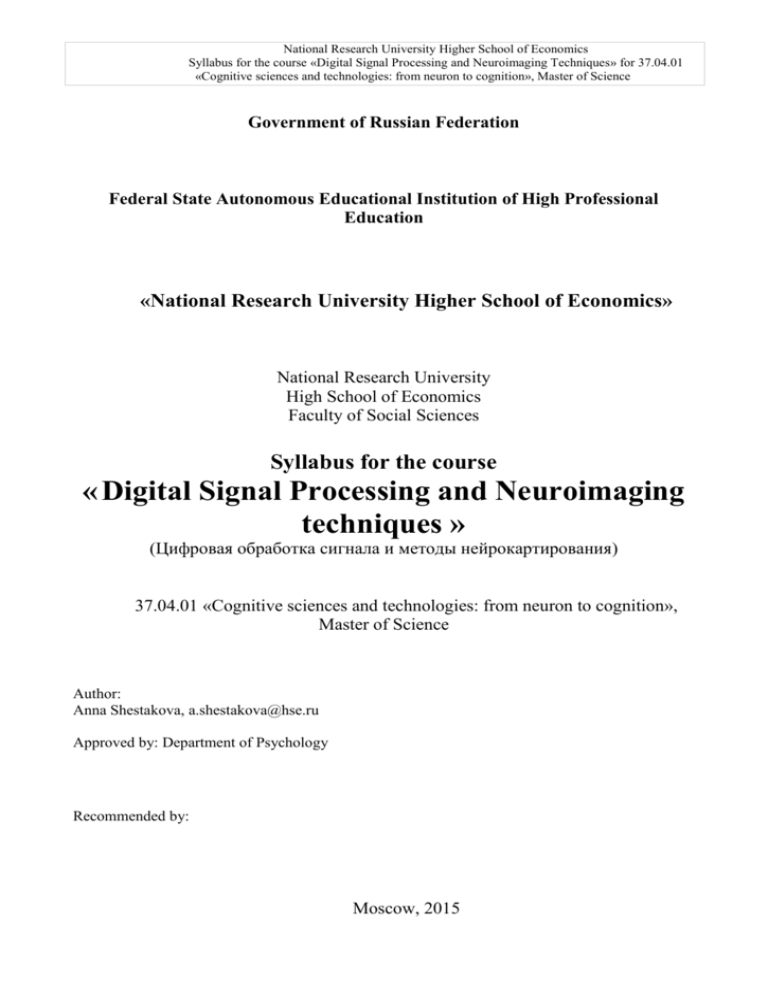
National Research University Higher School of Economics Syllabus for the course «Digital Signal Processing and Neuroimaging Techniques» for 37.04.01 «Cognitive sciences and technologies: from neuron to cognition», Master of Science Government of Russian Federation Federal State Autonomous Educational Institution of High Professional Education «National Research University Higher School of Economics» National Research University High School of Economics Faculty of Social Sciences Syllabus for the course « Digital Signal Processing and Neuroimaging techniques » (Цифровая обработка сигнала и методы нейрокартирования) 37.04.01 «Cognitive sciences and technologies: from neuron to cognition», Master of Science Author: Anna Shestakova, a.shestakova@hse.ru Approved by: Department of Psychology Recommended by: Moscow, 2015 National Research University Higher School of Economics Syllabus for the course «Digital Signal Processing and Neuroimaging Techniques» for 37.04.01 «Cognitive sciences and technologies: from neuron to cognition», Master of Science 1. Teachers Author, lecturer, course coordinator: Anna Shestakova , Faculty of Social Sciences, Department of Psychology, Center for cognition and decision making, senior scientist. Invited lecturers: Prorf. Matteo Feurra (Department of Pscyhology, HSE) Dr. Zapher Iscan (CDM-Centre) Prof. Alex Ossadtchi (CDM_Centre) Dr. Evgeny Blagoveshsnsky (CDM-Centre) Vadim Nikulin (Charite Hospital, Berlin, and CDM-Centre) Mario Martinez-Saito (CDM-Centre) Teaching assistant: Marco Colosio mcolosio@hse.ru 2. Scope of Use The present program establishes minimum demands of students’ knowledge and skills, and determines content of the course. The present syllabus is aimed at department teaching the course, their teaching assistants, and students of the Master of Science program 37.04.01 «Cognitive sciences and technologies: from neuron to cognition». This syllabus meets the standards required by: Educational standards of National Research University Higher School of Economics; Educational program «Psychology» of Federal Master’s Degree Program 37.04.01, 2014; University curriculum of the Master’s program in psychology (37.04.01) for 2014. 3. Summary Methods such as functional magnetic resonance imaging (fMRI), positron emission topography (PET), transcranial magnetic stimulation (TMS), Transcranial Direct Current Stimulation (tDCS) and Transcranial Alternating Current Stimulation (tACS), near-infrared spectroscopy (NIRS), also called optical imaging (OI), and optical provide us with new insights into the structure and function of the human brain along with more widely used electroencephalography (EEG). Recently, with the advent of superconductivity, a multichannel magnetoencephalography (MEG), the method that allow to record the activity of the same neural population as EEG does, came about and have been successfully applied for localizing sources in the brain. Nature and origin of electric, magnetic, NIRS, and bloodoxygen-level-dependent (BOLD) responses will be discussed throughout the course. In the modern science, system's based approach is frequently exercised as it allows to formalize the problems encountered in the real world by representing them in the well studied framework that provides for efficient analysis and solution. In order to get a full grip National Research University Higher School of Economics Syllabus for the course «Digital Signal Processing and Neuroimaging Techniques» for 37.04.01 «Cognitive sciences and technologies: from neuron to cognition», Master of Science of his powerful machinery researchers need to understand the fundamentals principles of the theory. The existing classes are either too specialized and mathematically detailed or too much of a cook-book nature. The goal of the second part of this class is to provide master students of non-mathematical background with a unifying view on the theory behind the system-oriented approach. The main goal is to develop the intuition behind the complex concepts. We will attempt to do it by showing the similarity of discrete and continuous treatments of the system's theory and interpret the results using the natural concepts of linear algebra 4. Learning Objectives This course aims at familiarizing students of our program with contemporary neuroimaging methods to study brain activity non-invasively with a particular emphasis on fMRI, MEG, multichannel EEG, TMS, tDCS, tACS, and NIRS (OI). Prior to the seminars and/or handson sessions on each methodology, an overview of basic principles and physics of the abovementioned techniques and methods will be provided. The course is structured such that it will start with the lectures on essentials and basic principles of core methodologies and continues with the advanced topics of the neuroimaging techniques. World leading experts in the a.m. and other methodologies such as e.g. newly developed ontogenetic or brainmachine interfaces will be invited as well. Biomedical applications of neuroimaging will be discussed throughout the lectures with the particular focus on the brain-machine interfaces which are developed et the HSE at the CDM Centre equipped with the brain-navigated TMS and multichannel EEG. 5. Learning outcomes After completing the study of the “Neuroimaging Techniques” the student should: be aware of the main spectrum of the neuroimaging techniques to non-invasively study the human brain function, understand their basic physical principles, biology, and mathematical computations underlying implementation of each of the core methodologies including electro- and magnetoencephalography (EEG/MEG), transcranial magnetic stimulation (TMS), transcranial alternating current stimulation (tACS), direct current stimulation (tDCS), near-infrared-spectroscopy (NIRS), functional magnetic resonance imaging (fMRI) and others. Also, students should know the definition of signal, basic model signal types, understand the difference between the continuous and discrete signals, be able to formally write an expression of an arbitrary signal, be able to show the link between the continuous and discrete treatments, be able to explain the role linear algebra plays in signal processing. Understand the notion of a transform, be able to interpret a transform in the linear algebra framework, be familiar with basic transforms used (Fourier transform, Wavelet transform), be able to formulate one’s own transform and write expressions for the coefficients and synthesis equation, be able to connect statistical properties of signals on both sides of the transform operation. After completing the study of the discipline «Neuroimaging techniques» the student should have the following competences: Competence Code Code (UC) The ability to reflect SC-1 SC-М1 Descriptors (indicators of achievement of the result) Educative forms and methods aimed at generation and development of the competence The student is able to reflect Lectures and National Research University Higher School of Economics Syllabus for the course «Digital Signal Processing and Neuroimaging Techniques» for 37.04.01 «Cognitive sciences and technologies: from neuron to cognition», Master of Science Competence Code Code (UC) developed methods of activity. The ability to propose a model to invent and test methods and tools of professional activity. The ability to independently become acquainted with new research methods, to change scientific profile of activity. The ability to improve and develop intelligent and cultural level, to build track of professional development and career. The ability to analyze, verify and assess the completeness of information during professional activity and work under ambiguity. The ability to conduct professional (including research) activity in international environment. SC-2 SC-M2 SC-3 SC-M3 SC-4 SC-M4 SC-6 SC-M6 SC-8 SC-M8 Capability to organize PC-1 IKindependent scientific, M1.2p/n research, consulting /i/k/pr_6 and applied activity on .1 the basis of juridical and professional standards and duties. The ability to PC-2 ICcommunicate orally M2.1_2. and in written form in 2_2.4.1_ English in the frame of 2.4.2. professional and Descriptors (indicators of achievement of the result) Educative forms and methods aimed at generation and development of the competence developed methods of activity based on main concepts and approaches of the Neuroimaging Techniques. The student is able to propose a model to invent and test methods of the non-invasive whole-brain neuroimaging. The student is able to independently become acquainted with new methods of the whole brain Neuroimaging Techniques. tutorials, group discussions, presentations, tests The student is able to improve and develop intelligent and cultural level, to build track of professional development and career based on the knowledge of cutting-edge non-invasive Neuroimaging Techniques The student is able to analyze, verify and assess the completeness of information about neuroimaging methods and work under ambiguity. Lectures, group discussions, tests, discussions of recommended literature, hands-ontraining. The student is able to conduct professional (including research) activity in international environment regarding main concepts of noninvasive Neuroimaging Techniques. The student is able to organize independent scientific, research, consulting and applied activity on the basis of juridical and professional standards and duties. Lectures, group discussions, colloquium, projects in mini-groups, discussions of essays. Lectures, group discussions, colloquium, projects in mini-groups, discussions of essays. Lectures and tutorials, group discussions, seminars, tests Tutorials, group discussions, handson-training, seminars. Lectures, group discussions, tests, discussions of recommended literature, hands-ontraining. The student is able to discuss group discussions, problems of cognitive science tests, quizzes both orally and in written form. National Research University Higher School of Economics Syllabus for the course «Digital Signal Processing and Neuroimaging Techniques» for 37.04.01 «Cognitive sciences and technologies: from neuron to cognition», Master of Science Competence Code Code (UC) scientific intercourse. The ability to use PC-4 ICmodern IT technologies M4.1_4. for search and 3_4.4. processing of information, work with professional databases and net communication. The ability to describe PC-5 ICproblems and situations M5.3_5. of professional activity 4_5.6_2. in terms of 4.1 humanitarian, economic and social sciences to solve problems which occur across sciences, in allied professional fields. The ability to detect, PC-8 SPC-M3 transmit common goals in the professional and social activities. Descriptors (indicators of achievement of the result) Educative forms and methods aimed at generation and development of the competence The student is able to use modern IT technologies for search and processing of information, work with professional databases and net communication to solve the Neuroimaging Techniques problems. The student is able to describe problems and situations of professional activity in terms of Neuroimaging Techniques. Tutorials, hands-on training The student is able to detect, transmit common goals in the field of the Neuroimaging Techniques . Discussion and analysis of the results of the home task and individual work Lectures, group discussions, tests, examinations 6. Place of the discipline in the Master’s program structure The “Neuroimaging Techniques ” course is one of the core introductory courses of the Programme that give and overview of the methodologies currently at place to study Cognition and Brain Function. The course is based on the previous Programme courses and is a prerequisite of acquiring knowledge in the successive courses. This course could be absolutely essential for the choice and understanding of the research methodology for once’ own experiments. The “Neuroimaging techniques” course is an attempt to give to Master’s students with nonbiological/mathematical/physical/background an overview of the methodologies currently used to uncover the mystery of the Human Mind. It is recommended for students of the Master’s program who are using or going to use the advanced neuroimaging methodologies in their experimental work. Prerequisites The following knowledge and competence are needed to study the discipline: A good command of the English language. A basic/school-level knowledge in biology, physics and mathematics. National Research University Higher School of Economics Syllabus for the course «Digital Signal Processing and Neuroimaging Techniques» for 37.04.01 «Cognitive sciences and technologies: from neuron to cognition», Master of Science Some basics of Calculus and Linear Algebra fundamentals, as well as knowledge obtained from the Neuroscience course of this Programme may be a plus. Main competences developed after completing the study this course can be used to learn the following disciplines: Cognitive Neuroscience Neuroeconomics Memory, Learning and Cognitive Development Neurobiology of Language Advanced neuroimaging and other Comparison with the other courses at HSE This class is unique in both the scope and the level of delivery that assumes only very basic physical, biological, and mathematical background. The main stress is on acquiring knowledge of what are the most frequently used methodologies to non-invasively study the human brain function, what are the fundamental physical, mathematical and biological principles behind them, what are the essences of engineering solutions, and, the last but not the least, how these methods can be used to better understand the Brain and Mind problem. Throughout the course, students are given excursions to the HSE Centre for Cognition & Decision Making (CDM-Centre) to observe how multichannel EEG and TMS, as well ass the tDCS and tACS work. Lectures are complemented by hands-on training sessions where students learn how to analysis prerecorded data provided by the lecturers e.g., data from multichannel EEG, MEG, MRI, fMRI experiments. Some classes are given by the world-leading experts in the Neuroimaging Techniques, both working and visiting HSE. The knowledge obtained by the students of this course should greatly facilitate their ability to read and understand the cutting-edge methodologies with which experiments of other scientist is conduced as well as open new horizons for them to plan their own studies. This class is unique in both the scope and the level of delivery that assumes only very basic mathematical background. The main stress is on building the intuition and teaching students to formalize the real-life problems and tackle them from the systems theory point of view. Signals, their properties and how they change when go through the system. Is time domain analysis the most convenient way for making sense of what an LTI systems does with the signal? This question leads to the introduction of transforms and the links to the state-space representation and linear algebra basics are shown illustrating that a transform is a simple change of basis operation. Which transforms are helpful? What do we learn when viewing signals in the transformed domain? Can we use transforms to analyze not only signals but systems? 7. Schedule One pair consists of 2 academic hours for lecture or 2 academic hours of practical session (seminar) Please, see the Course description section for assignment of lectures Course Units Module 1 (JanuaryMarch) Approx. number of academic hoursx Lectures Seminars Independent work 18 18 60 National Research University Higher School of Economics Syllabus for the course «Digital Signal Processing and Neuroimaging Techniques» for 37.04.01 «Cognitive sciences and technologies: from neuron to cognition», Master of Science 1. Introduction to Contemporary Neuroimaging Techniques 2. Essentials of electroencephalography, EEG/ Principles of EEG signal analysis 3. Essentials of magnetoencephalography, MEG/principles of MEG signal analysis 4. Essentials of transcranial magnetic stimulation, transcranial/principles of TMS signal analysis 5. Essentials of transcranial direct-current stimulation/principles of tDCS signal analysis 6. Essentials of functional magnetic resonance tomography (fMRI) / Principles of fRMI signal analysis 7. Essentials Near-infrared spectroscopy or Optical imaging Mid-Term exam Signals Transforms and decompositions Statistical description of signals in the original and transformed spaces Systems Practical examples and Summary Module 2 ( April– May) 2 2 6 2 2 6 4 4 6 2 2 8 2 2 8 4 4 8 2 2 6 2 2 8 6 6 10 6 6 10 6 6 10 2 20 20 40 8. Requirements and Grading Type of work Type of grading Final Participation/Quizzes/discussions/rea ding course materials Midterm test 1 Midterm test 2 Final exam (FE) Grade formula Characteristics # 20 1 Written test 1 Written test 1 Written exam 0.3*Participation+0.2*MTE1+ 0.2*MTE1+0.3*FE National Research University Higher School of Economics Syllabus for the course «Digital Signal Processing and Neuroimaging Techniques» for 37.04.01 «Cognitive sciences and technologies: from neuron to cognition», Master of Science 9. Assessment Overall assessment consists of classwork and homework. Students have to demonstrate their knowledge in each lecture topic concerning its fundamental aspects: from biological to mathematical, from psychological to physical. The topics are connected through the discipline and have increasing complexity. Intermediate assessment is given in the form of two midterm exams in written. Students have to demonstrate knowledge of the main concepts and facts taught during the corresponding module. The facts for answers can be retrieved from the class materials as well as from the recommended literature. The examples of the questions are provided before the examination. Final assessment is in the form of the final exam in written. Students have to demonstrate an ability to integrate the knowledge obtained in both modules: from essentials of the Neuroimaging techniques till the advances. A short assay of how the obtained knowledge on methodologies could help to conduct their master’s work could be an advantage The grade formula: Each midterm exam) will consist of 3 unique for each student questions, the average mark will be given for each exam Final exam will consist of 10 questions. The average will be calculated for the final grade. The assay about relevance of the neuroimaging techniques will give and extra point if the grade is lower than 10. Final course mark O is obtained from the following formula: Оfinal = 0,3*participation +0,2*Оmte1 +0,2*Оmte2 + 0.3*OFE The grades are rounded in favour of examiner/lecturer with respect to regularity of class and home works. All grades, having a fractional part greater than 0.5, are rounded up. Table of Grade Accordance Ten-point Grading Scale Five-point Grading Scale 1 - very bad 2 – bad 3 – no pass Unsatisfactory - 2 4 – pass 5 – highly pass Satisfactory – 3 6 – good 7 – very good Good – 4 8 – almost excellent 9 – excellent 10 – perfect Excellent – 5 FAIL PASS National Research University Higher School of Economics Syllabus for the course «Digital Signal Processing and Neuroimaging Techniques» for 37.04.01 «Cognitive sciences and technologies: from neuron to cognition», Master of Science 10. Course Description Methods such as functional magnetic resonance imaging (fMRI), positron emission topography (PET), transcranial magnetic stimulation (TMS), and, very recently, nearinfrared spectroscopy (NIRS), also called optical imaging (OI) and diffusion-tensor imaging (DTI), provide us with new insights into the structure and function of the human brain along with more widely used electroencephalography (EEG). Recently, with the advent of superconductivity, a multichannel magnetoencephalography (MEG), the method that allow to record the activity of the same neural population as EEG does, came about and have been successfully applied for localizing sources in the brain. This course aims at familiarizing students of our program with contemporary methods and to study brain activity noninvasively with a particular emphasis on fMRI, multichannel MEEG, as well as TMS and NIRS (OI). Prior to the seminars and/or hands-on sessions, an overview of basic principles and physics of the above-mentioned techniques and methods will be provided. Nature and origin of electric, magnetic, NIRS, and blood-oxygen-level-dependent (BOLD) responses will be discussed throughout the course. The students will start with understanding study designs of recent neuroimaging publications and continue with carrying out experiments (e.g. TMS and or EEG), analyzing fMRI and MEEG data. The course will be structured such that it will include lectures on essentials and basic principles of core methodologies including the hands-on training. Overview of main topics offered in the course Essentials of electroencephalography, EEG This part of the course is dedicated otthe Basics of electroencephalography, Main methods of EEG data analysis: coherence, ERD/ERS, ERPs and Many more Principles of EEG signal analysis. Introduction: Why EEG is used, pros and cons of electroencephalography History: Important people in EEG research Origin of EEG Signals: Neural activity, action potential, EEG rhythms, alpha activity Measurement of EEG: Electrodes, subject preparation, electrode locations, electrode montages, reference, spatial / time resolution, artefacts and noise, EEG amplifiers Applications of EEG: Epilepsy, brain computer interfaces, detection of the level of anesthesia, sleep analysis... etc. Recommended reading Buzsáki, G. Rhythms Of The Brain. Oxford: Oxford University Press, 2006. Print. For this EEG chapter, hands-on seminars are planned: Its goal is to introduce an idea of a Toolbox for EEG data analysis, e.g. EEGLAB, Brain Analyzer, etc. The knowledge of Matlab could be an advantage for this, but not necessary. Examples of questions: What is Electroencephalogram (EEG)? When was EEG discovered? What is the origin of brain activity? What are the basic EEG rhythms? How can we measure EEG? How can we process EEG signals? What are the application areas of EEG? Essentials of magnetoencephalography, MEG National Research University Higher School of Economics Syllabus for the course «Digital Signal Processing and Neuroimaging Techniques» for 37.04.01 «Cognitive sciences and technologies: from neuron to cognition», Master of Science With its absolute noninvasiveness, good accuracy in source location, and millisecondscale time resolution, the MEG (in combination with other brain imaging methods, e.g., MRI) has become a powerful tool for studying cerebral activity in humans. Minute changes in the magnetic field can be recorded using superconducting quantum interference devices (SQUIDs). An MEG signal can carry important information about sensory as well as higherlevel information processing in the brain. Because the MEG method is only sensitive to tangentially–oriented currents, and does not detect sources with an absolute radial orientation (Hämäläinen et al., 1993), it is most sensitive to activity in the fissural cortex and thus has great potential in terms of studying the auditory function in humans. Indeed, pyramidal cells — the largest cortical neurons in the auditory cortex — are oriented so that the primary current generated by them has a tangential orientation to the surface of the brain. The evoked magnetic fields are considered to be counterparts of the corresponding eventrelated potentials (Romani et al., 1982; Pantev etHamalainen et al., 2006Magnetoencephalography –theory, instrumentation, and applications to noninvasive studies of the working human brain The evoked magnetic fields are considered to be counterparts of the corresponding event-related potentials (Romani et al., 1982; Pantev et al., 1988; Hari, 1990; Tiitinen et al., 1993; Huotilainen et al., 1998). Moreover, the auditory event-related magnetic fields (ERFs), obtained by averaging MEG signals time locked to the auditory stimulation, have proved to be very useful for studying the anatomical and functional organization of the auditory cortex in humans (Pantev et al., 1988; Hämäläinen et al., 1993; Huotilainen et al., 1995; Huotilainen et al., 1998). Recommended reading Hämäläinen, Matti et al. ' Magnetoencephalography—theory, instrumentation, and applications to noninvasive studies of the working human brain'. Reviews of Modern Physics 65.2 (1993): 413-497. Makela, Jyrki P. et al. 'Magnetoencephalography In Neurosurgery'. Neurosurgery 59.3 (2006): 493-511. Web. Examples of questions Why are pyramidal cells considered the main source of MEG signal. Why it is not recommended to enter the MEG room with a metal spoon in a cup of tea? Earth geomagnetic field? 10-4 (av. Milli and micro) – What is the magnetic field amplitude that is measured with the SQUID? What is the MEG signal units? Where is Josephson junction used? In which methodology? What is the differences between gradiometers and magnetometers? What is the course of Primary currents Jp. What is the source of Volume currents Jv ? What is electromagnetic induction? Which laws are included in the system of Maxwell equations? Essentials of transcranial magnetic stimulation, TMS & principles of TMS signal analysis This part will be devoted to the basic principles of Transcranial Magnetic Stimulation, a powerful tool for stimulation and non-invasive probing of cortical excitability and connectivity of the human brain. Magnetic brain stimulation follows the fundamental physical principles of electromagnetic induction such that physics of TMS is converse to MEG. We shall follow the progress of TMS research from which it is evident that TMS has become an efficient instrument to study cognitive functions such as language, memory and a powerful method for cortical mapping of perception and motor functions to name a few. Through reading experimental article, we shall learn that clinical applications of TMS are ample. National Research University Higher School of Economics Syllabus for the course «Digital Signal Processing and Neuroimaging Techniques» for 37.04.01 «Cognitive sciences and technologies: from neuron to cognition», Master of Science The Lecture will be complemented with the Laboratory demonstrations of the TMS ongoing research in Cognition and Decision Making. Recommended reading Bailey, Christopher J., Jari Karhu, and Risto J. Ilmoniemi. 'Transcranial Magnetic Stimulation As A Tool For Cognitive Studies'. Scand J Psychol 42.3 (2001): 297-306. Bestmann, Sven. 'The Physiological Basis Of Transcranial Magnetic Stimulation'. Trends in Cognitive Sciences 12.3 (2008): 81-83. Butler, Andrew J et al. 'Finger Extensor Variability In TMS Parameters Among Chronic Stroke Patients'. Journal of NeuroEngineering and Rehabilitation 2.1 (2005): 10. Examples of questions What does r in rTMS stand for? What is n in nTMS stand for? What does EMG stand for? How is it different from MEG? What is the difference between ERP and MEP? Why is the TMS theory is converse to MEG? How to calculate the Flux of magnetometer coil? Why a 3D focusing is not possible for TMS? What does Lenz’s low define? What happens at the axon membrane when the brain is noninvasively stimulated by the TMS? Essentials of functional magnetic resonance tomography (fMRI) This lecture introduces students to basics of functional magnetic resonance imaging (fMRI). We start from an overview of the physical phenomenon such as nuclear resonance imaging (NRI) and its relevance for MRI of the brain. The principle idea behind a modern MR scanner and its basic working principles will be outlined. We then continue with different ways to scan the brain, particularly echo-planar imaging. The main issues are addressed to neurophysiological meaning of BOLD signal. A large spectrum of fMRI designs to study brain functions and standard approaches to analyze fMRI data. In order to give an idea of how the fRMI data analysis work, a linear systems framework of FMRI, i.e. GLM notion will be discusses throughout this section of the course. This part is likely to be complemented with the demonstration of fRMI data analysis. Recommended reading ∙ Huettel, Song, McCarthy (eds) Functional magnetic resonance imaging. Sinauer 2004 ∙ Logothetis NK (2008) What we can do and what we cannot do with fMRI. Nature 453:869–878. (pdf in the dropbox) Examples of questions 1. 2. 3. Basic concepts of BOLD-fMRI Neurophysiology of BOLD response: neurovascular coupling Limitations of BOLD-fMRI for cognitive studies Essentials of Near-infrared spectroscopy, NIRS or optical imaging, OI This part of the course wilbe devoted to outlining a very promising yet not fully developed methodology of the so-called near-infraraed spectroscopy, a subclass of optical imagin techniues for studying the whole brain function in humans. U sing near-infrared light that can penetrate biological tissue reasonably well, it has become possible to assess brain activity in human subjects through the intact skull non-invasively. After early studies employing single-site near-infrared spectroscopy, first near-infrared imaging devices are National Research University Higher School of Economics Syllabus for the course «Digital Signal Processing and Neuroimaging Techniques» for 37.04.01 «Cognitive sciences and technologies: from neuron to cognition», Master of Science being applied successfully for low-resolution functional brain imaging. Advantages of the optical methods include biochemical specificity, a temporal resolution in the millisecond range, the potential of measuring intracellular and intravascular events simultaneously and the portability of the devices enabling bedside examinations. Recommended literature Minagawa-Kawai, Y. et al. 'Neural Attunement Processes In Infants During The Acquisition Of A Language-Specific Phonemic Contrast'. Journal of Neuroscience 27.2 (2007): 315-321. Minagawa-Kawai, Yasuyo et al. 'Optical Imaging Of Infants' Neurocognitive Development: Recent Advances And Perspectives'. Devel Neurobio 68.6 (2008): 712-728. Villringer, A. 'Non-Invasive Optical Spectroscopy And Imaging Of Human Brain Function'. Trends in Neurosciences 20.10 (1997): 435-442. Zeff, B. W. et al. 'Retinotopic Mapping Of Adult Human Visual Cortex With High-Density Diffuse Optical Tomography'. Proceedings of the National Academy of Sciences 104.29 (2007): 12169-12174. Zeff, B. W. et al. 'Retinotopic Mapping Of Adult Human Visual Cortex With High-Density Diffuse Optical Tomography'. Proceedings of the National Academy of Sciences 104.29 (2007): 12169-12174. Linear Systems Theory The second part of the class is dedicated to studying linear systems theory that form foundation for most modern algorithms of data analysis . The following set of topics will be covered Signals [lecture 1] 1.1 Deterministic Signals (discrete, continuous) 1.2 Random signals, random processes 1.3 Signals as vectors 1.4 Hilbert space, infinite dim Eucledian space, notion of distance 1.5 Demonstrated equivalence of discrete and continuous forms of treatment Transforms and decompositions [lectures 2,3,4] 2.1 General idea of a transform 2.2 A transform as a change of basis 2.3 Calculating transform coefficients or why do we need an orthogonal basis? 2.4 Fourier transform 2.5 State-space representation and discrete transforms as a matrix-vector multiplication 2.6 Time-frequency representation of signals 2.7 Short-time Fourier transform 2.8 Wavelet transform Statistical description of signals in the original and transformed spaces [5,6,7] 3.1 Second order statistical description of random signals revisited 3.2 Periodogram, Power spectral density(PSD) 3.3 Wiener-Hinchin theorem National Research University Higher School of Economics Syllabus for the course «Digital Signal Processing and Neuroimaging Techniques» for 37.04.01 «Cognitive sciences and technologies: from neuron to cognition», Master of Science 3.4 Methods to compute PSD Systems [8,9,10] 4.1 Input-output relation, a system as an operator 4.2 Calculation of an output of a system for an arbitrary input, pulse response 4.3 Linear time invariant (LTI) systems 4.4 Transient processes 4.5 Passing random process through an LTI system 4.6 Time domain 4.7 Frequency domain, Transfer function or why a linear system cannot “bring in new frequencies” 4.8 Z- transform as a method for analysis of discrete-time LTIs 4.9 Digital Temporal filters as most frequently used LTIs 4.10 FIR, IIR filters, 4.11 Stability, implementation details 4.12 Digital filters as shaping filters for ARMA processes 4.13 Synthesis of signals with desired second order statistical properties Reading materials for the second part of the class: Selected chapters from Oppenheim A. and Schafer R. (1989 or newer) Discrete time signal processing, Prentice Hall signal processing series, ISBN 0-13-216292-X. Sharma S. (1996) Applied multivariate techniques, John Wiley & Sons, Inc Kay S. (1993) Fundamentals of statistical signal processing, Prentice Hall signal processing series, ISBN 0-13-345711-7. Casella G., Berger R.(1990) Statistical inference, Wadsworth and Brooks/Cole Advanced Books & Software, Pacific Grove, California, ISBN 0-534-11958-1 Strang, G. (2009). Introduction to Linear Algebra, 4th edition, Wellesley-Cambridge Press. 17. Recommended Reading Mark Wickert, Signals and systems for dummies, paperback, ISBN-13: 978-1118475812, 1st edition, S.L. Marple Jr, Digital Spectral Analysis with Applications: Second Edition, 2014, Prentice Hall signal processing series National Research University Higher School of Economics Syllabus for the course «Digital Signal Processing and Neuroimaging Techniques» for 37.04.01 «Cognitive sciences and technologies: from neuron to cognition», Master of Science 11. Educational Technology The following educational technologies are used in the study process: • Lectures involving continuous use of multimedia presentations, demonstrations and movies. • Self-study of required readings • • Hands-on trainings and presentation of practical aspects of applying methodologies • discussion and analysis of topics in the group; • essays involve critical thought and presentation of a selected topic 12. Recommendations for course lecturer Course lecturers are advised to use interactive learning methods, which allow participation of the majority of students, such as slide presentations, combined with writing materials on board, and usage of interdisciplinary papers to present multidisciplinary nature of the current research methodologies to study human brain function 13. Recommendations for students The course is interactive. Lectures are combined with classes. Students are invited to ask questions and actively participate in group discussions. There will be special office hours for students, which would like to get more precise understanding of each topic. Teaching assistant will also help you. All tutors are ready to answer your questions online by official e-mails that you can find in the “contacts” section. 14. Examples of Final exam questions Name most powerful methodologies to study the whole brain function What is the scope of methodologies you can have access to here at HSE? Give an example of methodologies which can be characterized by high temporal/ spatial resolution What is the difference between functional MRI and structural MRI? What does the peristimulus time l histogram reflect? How is it different from the single spike? Define action potential? What is the main source of EEG signal? What is the main source of the MEG signal? What is the ERP and which forms of ERP signal representation do you know? What is the difference between topographical and tomographic images? What is the differences between electro- and magnetoencephalography? What is SQUID abbreviation stands for? What is the difference between electric and magnetic (Transcranial magnetic stimulation?) How does the brain navigation system for nTMS works? Ascribe the engineering principle in brief. What does BOLD abbreviation stand for? Imaging you are back in 19th century when no fMRI would be available. What would be your BOLD experiment then? What is the NIRS abbreviation stand for? What is the difference between NIRS and fMRI? What is the similarity? Can you recall other types of medical topographical imaging techniques other than fMRI and NIRS, that use electromagnetic waves as a working principle? Name a few. Ascribe the idea of dipole fitting. What does the ECD abbreviation stand for? What is the difference between the single and multiple source analysis? What is the difference between the Evoked potential, EP and evoked field, EF National Research University Higher School of Economics Syllabus for the course «Digital Signal Processing and Neuroimaging Techniques» for 37.04.01 «Cognitive sciences and technologies: from neuron to cognition», Master of Science What is forward problem in electromagnetism? What is Inverse modeling in electromagnetism? Please, give an example of a distributed model. What is the Lead field concept. Lead field is a…. Why are pyramidal cells considered the main source of MEG signal. Why it is not recommended to enter the MEG room with a metal spoon in a cup of tea? Earth geomagnetic field? 10-4 (av. Milli and micro) – What is the magnetic field amplitude that is measured with the SQUID? What is the MEG signal units? Where is Josephson junction used? In which methodology? What is the differences between gradiometers and magnetometers? What is the course of Primary currents Jp. What is the source of Volume currents Jv ? What is electromagnetic induction? Which laws are included in the system of Maxwell equations? Try to remember mathematical equation for an Ampere’s law, Faraday’s law, Hauss’s law If not, try to explain it either graphically or in words. Either way would do. What does r in rTMS stand for? What is n in nTMS stand for? What does EMG stand for? How is it different from MEG? What is the difference between ERP and MEP? Why is the TMS theory is converse to MEG? How to calculate the Flux of magnetometer coil? Why a 3D focusing is not possible for TMS? What does Lenz’s low define? What happens at the axon membrain when the brain is noninvasively stimulated by the TMS? 15. Reading and Materials This course is intended to provide students with the overview of the most powerl research methodologies to study the human brain function. For each methodology an ample amount of reading material is offered: both for the essentials and advances. Pdfs of lecture materials, reviews, research articles, and book chapters are provided as well as the reference to extracurriculum materials that can be of interest for the studenets 16. Required Reading The focus of this course is to better understand modern trends in developing research approaches to tackle the mind and brand problem. This demand skills to freely navigate through the broad range of methodologies. No single or uniformed book exists or may exist for the course on and consequently there is no such thing as required reading for this course. However, as examples of the questions are provided before the exams, the students may retrieve the information from the Recommended literature and the course materials which are properly annotated and put in order for each course topics. 17. Recommended Reading Buzsáki, G. Rhythms Of The Brain. Oxford: Oxford University Press, 2006. Print. 18. List of papers for review Hämäläinen, Matti et al. ' Magnetoencephalography—theory, instrumentation, and applications to noninvasive studies of the working human brain'. Reviews of Modern Physics 65.2 (1993): 413-497. Bailey, Christopher J., Jari Karhu, and Risto J. Ilmoniemi. 'Transcranial Magnetic Stimulation As A Tool For Cognitive Studies'. Scand J Psychol 42.3 (2001): 297-306. Bestmann, Sven. 'The Physiological Basis Of Transcranial Magnetic Stimulation'. Trends in Cognitive Sciences 12.3 (2008): 81-83. Butler, Andrew J et al. 'Finger Extensor Variability In TMS Parameters Among Chronic Stroke Patients'. Journal of NeuroEngineering and Rehabilitation 2.1 (2005): 10. National Research University Higher School of Economics Syllabus for the course «Digital Signal Processing and Neuroimaging Techniques» for 37.04.01 «Cognitive sciences and technologies: from neuron to cognition», Master of Science ∙ Huettel, Song, McCarthy (eds) Functional magnetic resonance imaging. Sinauer 2004 ∙ Logothetis NK (2008) What we can do and what we cannot do with fMRI. Nature 453:869–878. (pdf in the dropbox) Minagawa-Kawai, Y. et al. 'Neural Attunement Processes In Infants During The Acquisition Of A Language-Specific Phonemic Contrast'. Journal of Neuroscience 27.2 (2007): 315-321. Minagawa-Kawai, Yasuyo et al. 'Optical Imaging Of Infants' Neurocognitive Development: Recent Advances And Perspectives'. Devel Neurobio 68.6 (2008): 712-728. Villringer, A. 'Non-Invasive Optical Spectroscopy And Imaging Of Human Brain Function'. Trends in Neurosciences 20.10 (1997): 435-442. Zeff, B. W. et al. 'Retinotopic Mapping Of Adult Human Visual Cortex With High-Density Diffuse Optical Tomography'. Proceedings of the National Academy of Sciences 104.29 (2007): 12169-12174. Zeff, B. W. et al. 'Retinotopic Mapping Of Adult Human Visual Cortex With High-Density Diffuse Optical Tomography'. Proceedings of the National Academy of Sciences 104.29 (2007): 12169-12174. Nolte, Guido et al. 'Identifying True Brain Interaction From EEG Data Using The Imaginary Part Of Coherency'. Clinical Neurophysiology 115.10 (2004): 2292-2307. Pfurtscheller, G., and F.H. Lopes da Silva. 'Event-Related EEG/MEG Synchronization And Desynchronization: Basic Principles'. Clinical Neurophysiology 110.11 (1999): 1842-1857 Voss U, Holzmann R, Hobson A, Paulus W, Koppehele-Gossel J, Klimke A, et al. Induction of self awareness in dreams through frontal low current stimulation of gamma activity. Nat Neurosci (2014) 17:810–2 Feurra M., Pasqualetti P., Bianco G., Santarnecchi E., Rossi A., Rossi S. (2013). State-dependent effects of transcranial oscillatory currents on the motor system: what you think matters. J. Neurosci. 33, 17483–17489 Feurra M, Bianco G, Santarnecchi E, Del Testa M, Rossi A, Rossi S (2011). Frequency-dependent tuning of the human motor system induced by transcranial oscillatory potentials. J Neurosci 31:12165–12170. Wagner, T, Valero-Cabre, A, and Pascual- Leone, A (2007). Noninvasive human brain stimulation. Annu. Rev. Biomed. Eng. 9, 527–565 .Friston KJ. Functional and effective connectivity: a review. Brain Connect. 2011; 1: 13-36. 2. van den Heuvel MP, Hulshoff Pol HE. Exploring the brain network: A review on resting-state fMRI functional connectivity. European Neuropsychopharmacology. 2010; 20: 519-534. 3. Erhardt EB, Rachakonda S, Bedrick E, Allen E, Adali T, Calhoun VD. Comparison of multi-subject ICA methods for analysis of fMRI data. Hum Brain Mapp. 2011; 32: 2075-2095. Lebedev M.A., Carmena J.M., O'Doherty J.E., Zacksenhouse M., Henriquez C.S., Principe J.C., Nicolelis M.A. (2005) Cortical ensemble adaptation to represent velocity of an artificial actuator controlled by a brain-machine interface. J. Neurosci., 25: 4681-4693. Lebedev M.A., Nicolelis M.A. (2006) Brain-machine interfaces: past, present and future. Trends Neurosci., 29: 536546. Bass, Caroline E. et al. 'Optogenetic Stimulation Of VTA Dopamine Neurons Reveals That Tonic But Not Phasic Patterns Of Dopamine Transmission Reduce Ethanol Self-Administration'. Frontiers in Behavioral Neuroscience 7 (2013): Belzung, Catherine, Marc Turiault, and Guy Griebel. 'Optogenetics To Study The Circuits Of Fear- And DepressionLike Behaviors: A Critical Analysis'. Pharmacology Biochemistry and Behavior 122 (2014): 144-157. 18. Course telemaintenance All materials of the discipline are posted in informational educational site at NRU HSE portal www.hse.ru . Students are provided with links on relevant papers, tests, electronic books, articles, etc. 19. Equipment The course requires a laptop, projector, and acoustic systems to give lectures and the computer class with the MAtLab and SPM to give hands-on classes. Course structure and the syllabus are prepared by Anna Shestakova, Ph.D. Selected topics, lecture annotations and lecture materials are prepared by the co-teachers: National Research University Higher School of Economics Syllabus for the course «Digital Signal Processing and Neuroimaging Techniques» for 37.04.01 «Cognitive sciences and technologies: from neuron to cognition», Master of Science for example, ‘ Essentials of electroencephalography’ is taught by Dr. Zafer Iscan, ‘Essentials of functional magnetic resonance tomography (fMRI) / Principles of fMRI signal analysis ‘ by Dr. Anna Shestakova and Dr Mario Martinez-Saito, Complementing topics such as the bellow mentioned will be likely covered during the Research Seminar Series “Cognitive Psychophysiology fundamental and applied apspects: Functional Connectivity by V. Balayev, GLM framework by Mario Martinez-Saito, tDCS/tACS by Matteo Feurra, advances of TMS by Evgeny Blagoveshensky, Models of source analysis by Alex Ossadtchi, Advances of electroencephalography , EEG/ Neuronal oscillations in Neuroimaging (Vadim Nikulin Neurophysics Group, Department of Neurology, Campus Benjamin Franklin, Charité - University Medicine Berlin & the Centre for Cognition), Optogenetics as a new tool of brain electrophysiology (Evgeny Budygin Wake Forest School of Medicine, Winston-Salem, USA)
